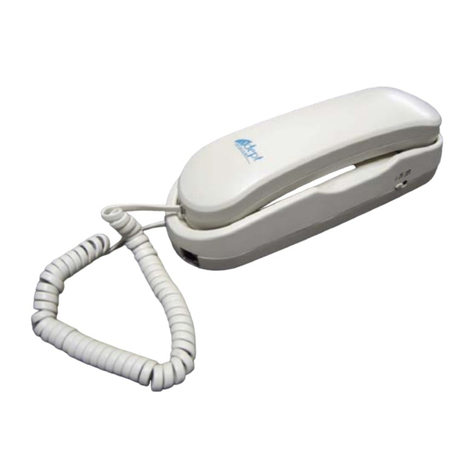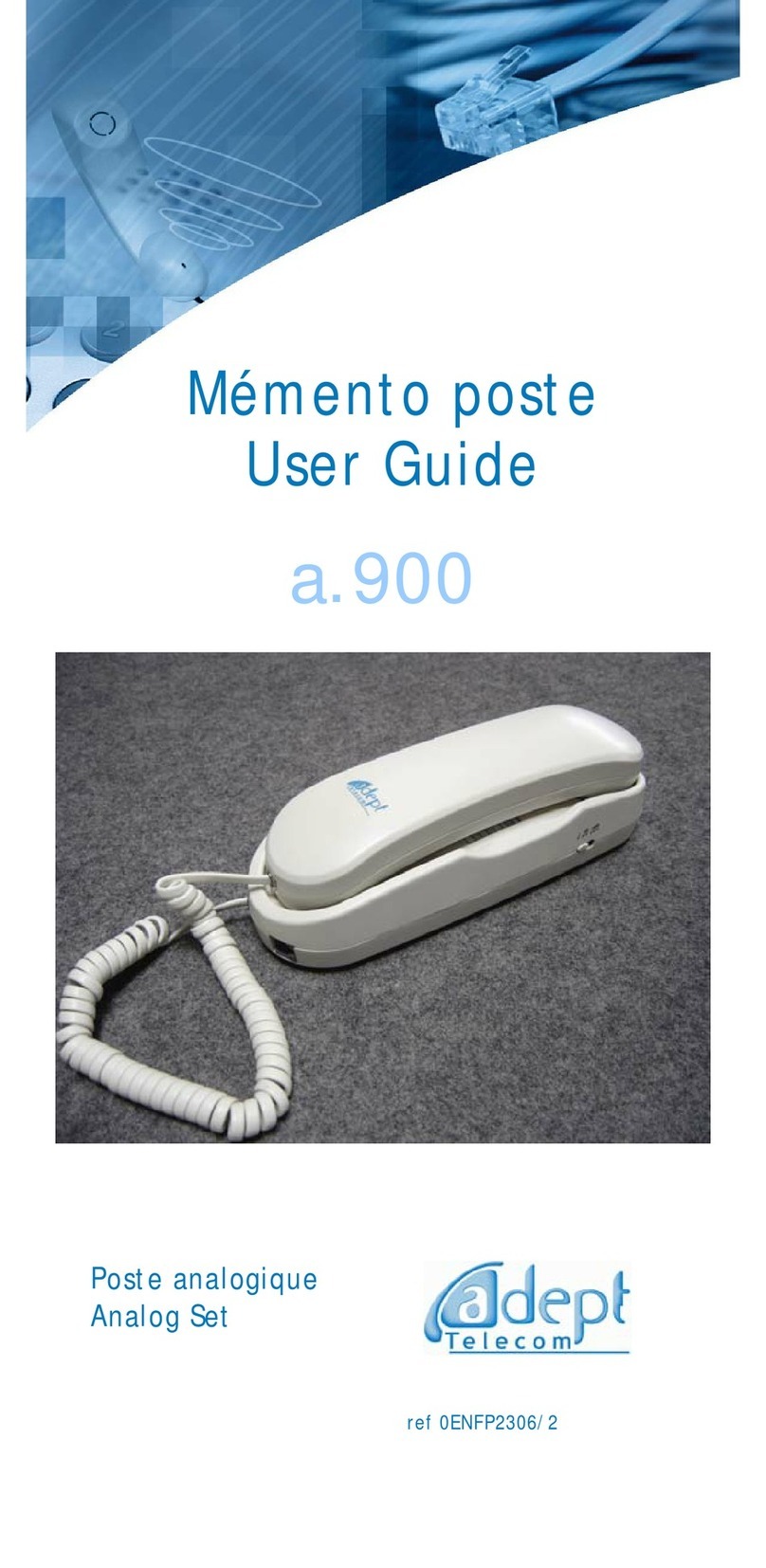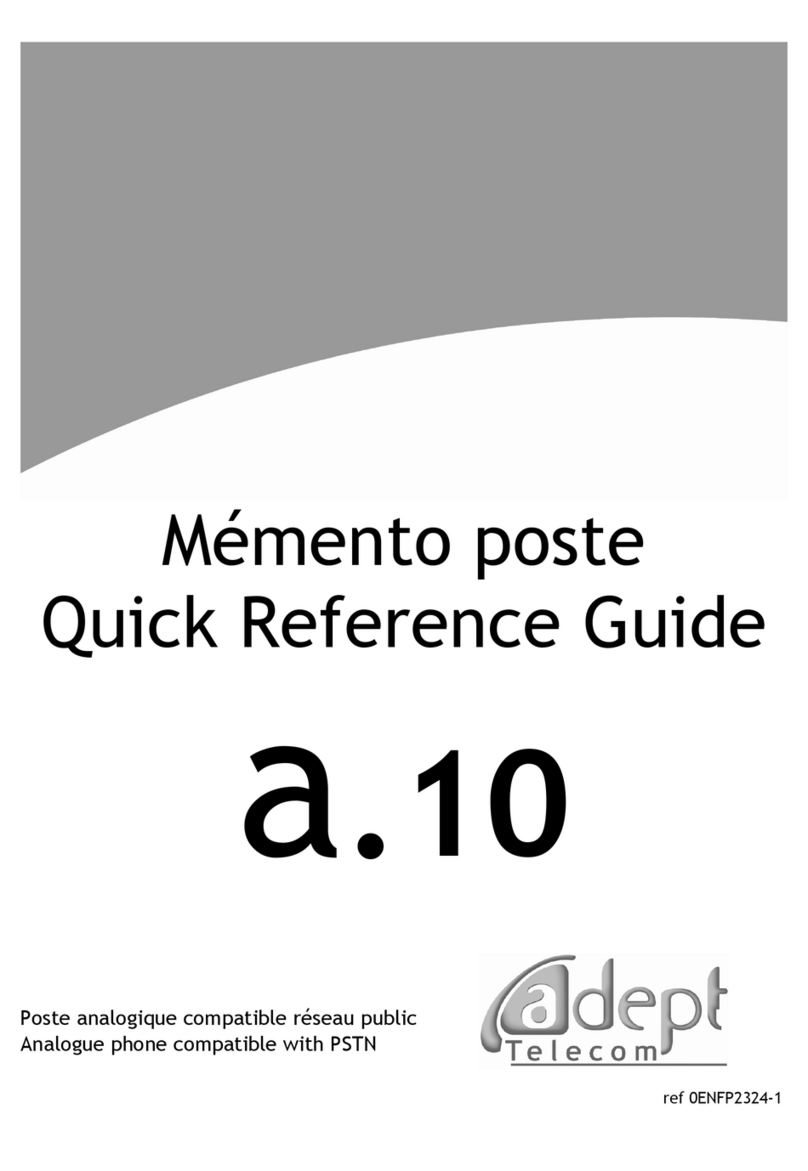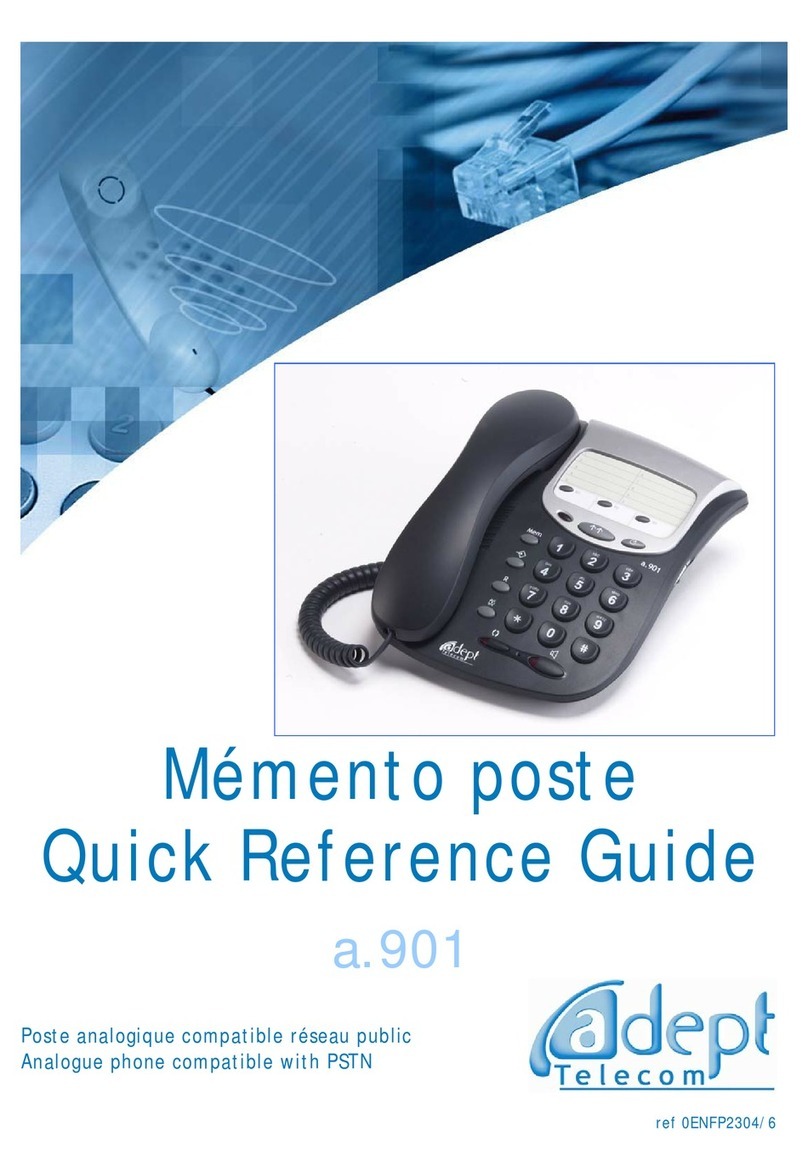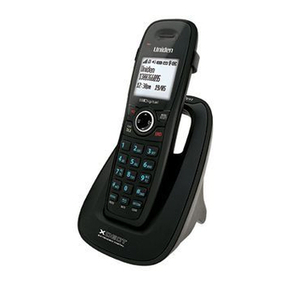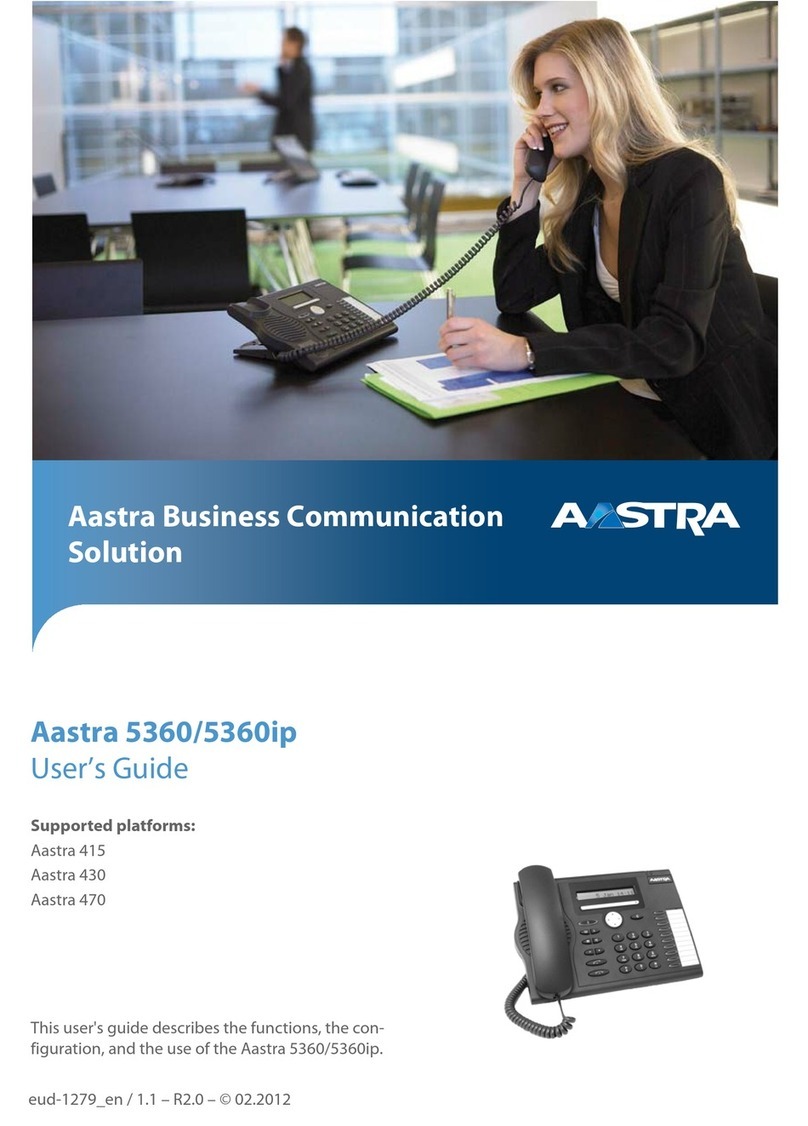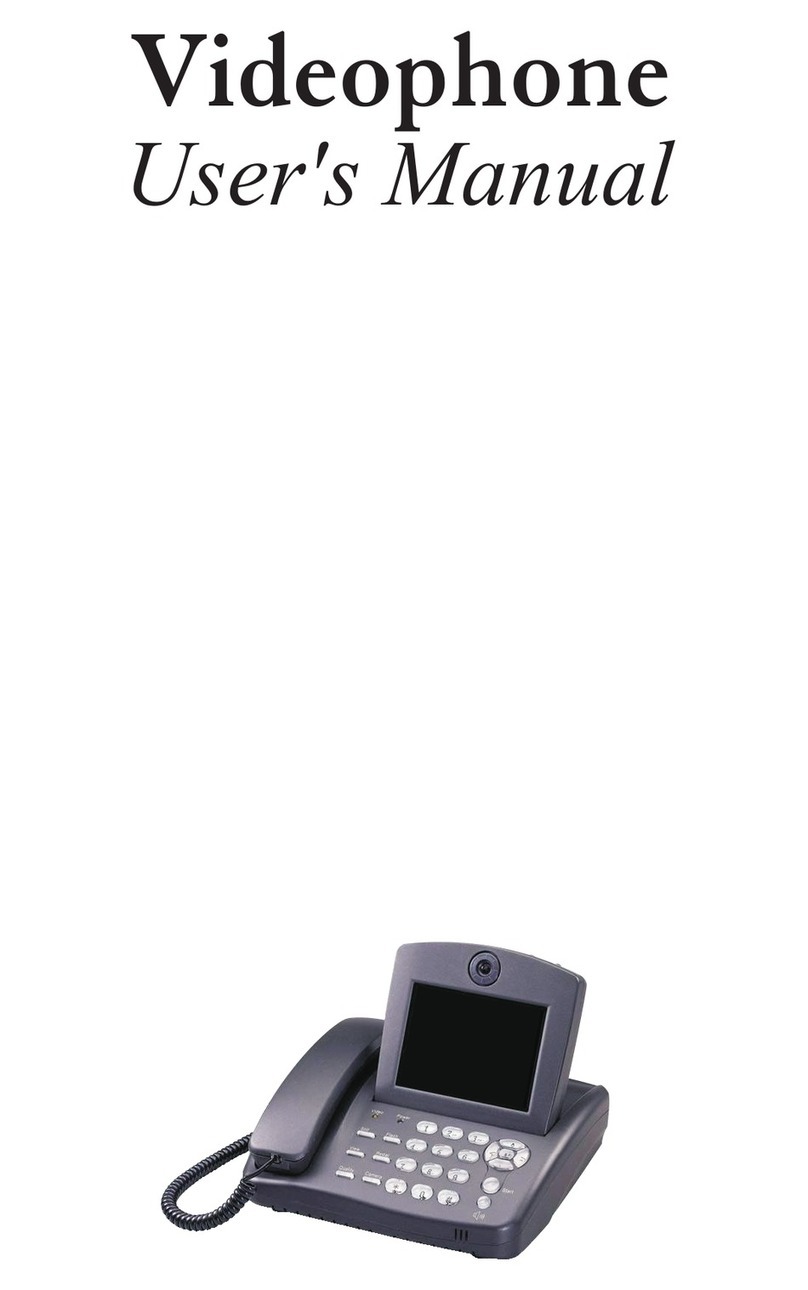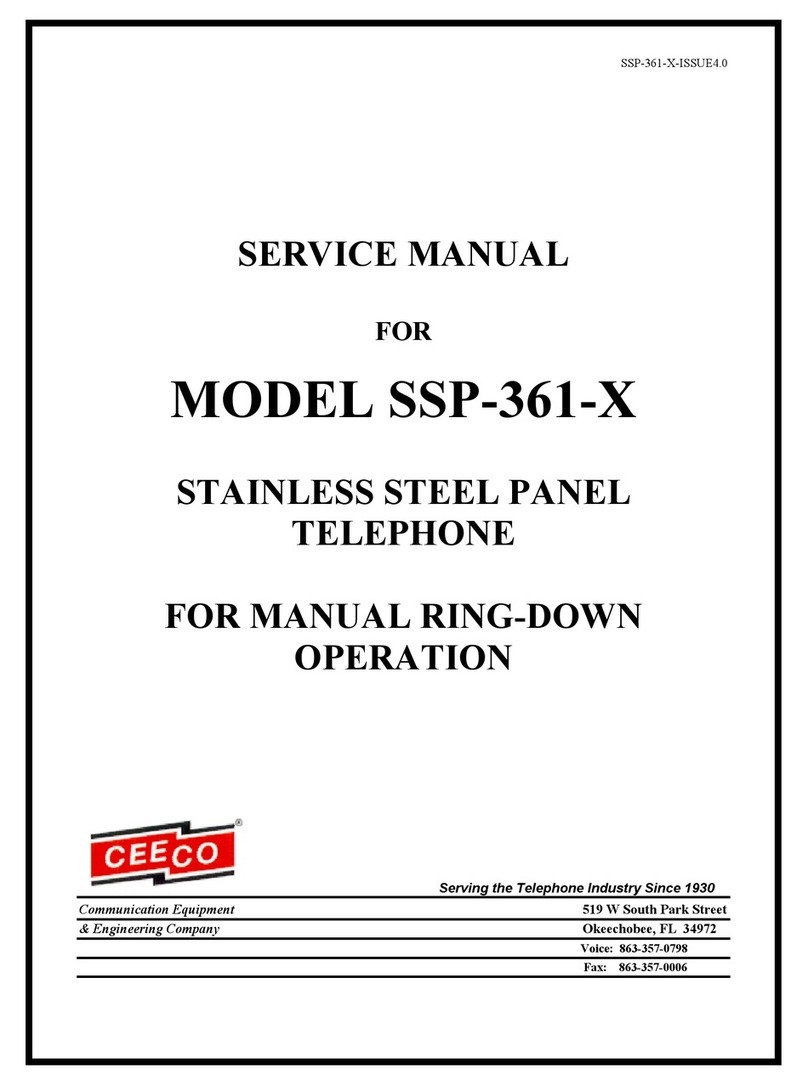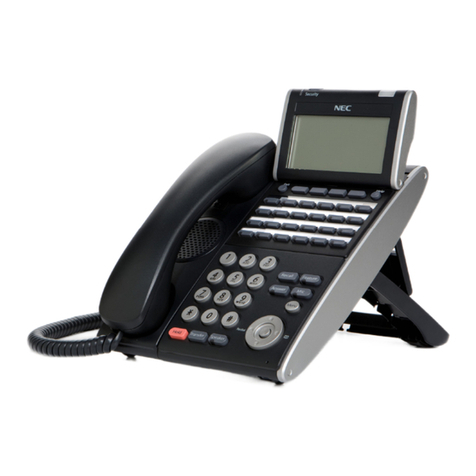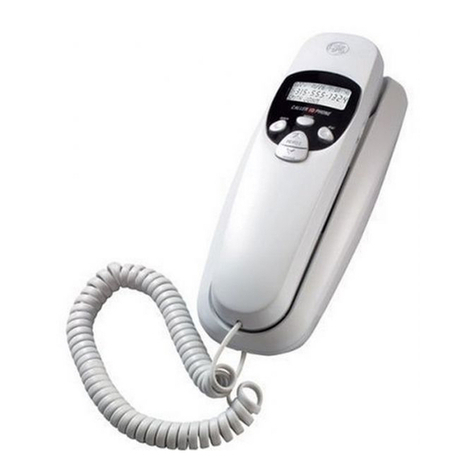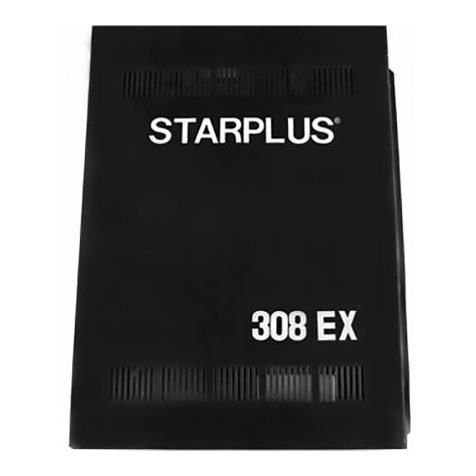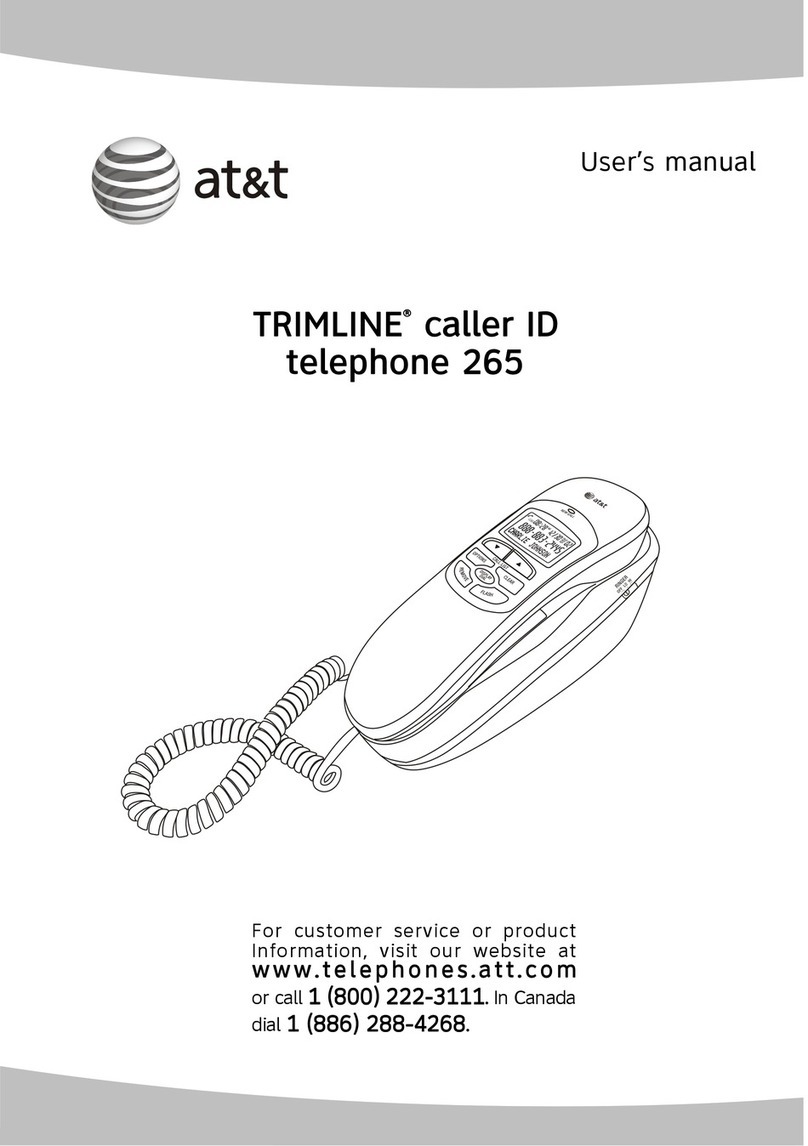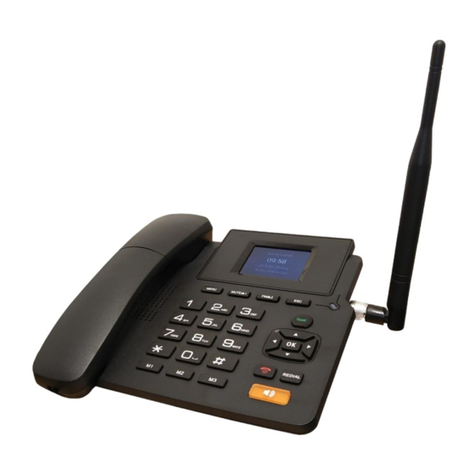ADEPT Telecom a.910 User manual

Mémento poste
Quick Reference Guide
a.910
Poste analogique compatible réseau public
Analogue phone compatible with PSTN
ref 0ENFP2302-6

a.910 – 07-2005 2
Langue française
Réglage volume sonnerie
Voyant appel entrant
Validation menu / Appel
Mémorisation saisie
CEffacement / Correction saisie
Touches et mémo mémoires
¶Réglage contraste
Mem Accès mémoires
RFlashing
Mise en attente / Sortie menu
ÇÇ Bis
;Mains-libres
Accès répertoire
ÉAccès liste des appels émis
Volume haut
p
arleur
TS Défilement / Liste des
appels émis
ÌVoyant appel en absence
Réglage mélodie sonnerie

a.910 – 07-2005 3
Dans ce mémento, signifie « Décrocher ». signifie « Raccrocher »
désigne une manipulation, à suivre le cas échéant dans un ordre indiqué par , , ou
PRESENTATION
a.910 est compatible avec les standards ADEPT Telecom et peut être raccordé sur le réseau public
analogique. Pour le raccordement sur un PABX d’autre marque, veillez à vérifier la compatibilité avec votre
fournisseur d’équipement.
Le poste a.910 est livré avec une pièce plastique amovible qui permet d’incliner le poste lorsqu’il est posé sur
un bureau.
MISE EN SERVICE
Avant toute utilisation ou programmation, votre poste a.910 doit être alimenté par trois piles de type AA
LR6. Celles-ci sont à placer dans le compartiment situé au dos de l’appareil. Ce compartiment s’ouvre et
se ferme à l’aide d’un tournevis cruciforme. Il est impératif de retirer le cordon ligne avant d’insérer
les piles, dans le cas d’une première installation ou d’un changement de piles. Lors d’un changement
de piles, il est conseillé de procéder au changement en moins de 5 secondes afin de conserver les
données en mémoire.
Après avoir placé les piles, raccordez le cordon « ligne », dans la prise prévue à cet effet à l'arrière du
poste. Ce cordon RJ11/RJ11 sera enfiché dans l’adaptateur pour prise téléphonique fourni.
Raccordez le cordon du combiné, dans la prise prévue à cet effet sur le côté du poste.
UTILISATION EN POSITION MURALE
Le poste a.910 peut être mis en position murale en positionnant deux vis murales fournies dans les
emplacements prévus à cet effet au dos du poste. Placez ces vis au mur, distantes de 9 centimètres selon un
axe vertical.
Décrochez le combiné et retournez l’ergot situé sous la bascule de raccroché. Le combiné peut alors être
maintenu raccroché en position murale.
En position décroché, le combiné peut aussi être maintenu posé sur le poste grâce à un ergot situé sur la
partie supérieure du poste. Le combiné prévoit une fente qui vient s’enficher sur l’ergot poste.
PERSONNALISATION
Mélodie de la sonnerie
Un commutateur situé à l’arrière du poste permet de sélectionner la mélodie de sonnerie parmi 3.
Volume de la sonnerie
Un commutateur situé à l’arrière du poste permet de sélectionner le niveau de sonnerie parmi 3 : Elevé,
Moyen ou Silence. En position «Silence », un appel entrant est signalé par clignotement du voyant d’appel
« ».
Fréquences Vocales ou Impulsions Décimales (Pulse/Tone)
Le poste a.910 peut fonctionner en fréquences vocales (Tone) ou en impulsions décimales (Pulse). Le choix
s’effectue grâce au commutateur situé au dos du poste.
Volume du haut-parleur
Le volume du haut parleur se règle à l’aide du curseur situé à droite.
Accès au menu « Options »
Un appui long sur la touche « » fait apparaître le menu « OPTIONS ». Par appui sur les touches Set T,
différentes options sont paramétrables. Validez le sous-menu choisi par « ».

a.910 – 07-2005 4
Choix de la langue (français, espagnol, allemand, italien, portugais, anglais)
Sélectionnez la langue d’affichage par les touches Set T. Validez par « ».
Choix de la zone
Ce menu est inopérant en France.
Heure et Date
L’heure clignote. Faites défiler les valeurs par Set T. Validez par « ».
Les minutes clignotent. La procédure est identique et permet ensuite de modifier le jour puis le mois.
Définition du Flashing
Sélectionnez la valeur par les touches Set T. Validez par « ». Pour la France, choisissez 300 Ms.
Contraste
Sélectionnez l’un des huit niveaux de contraste afficheur par les touches Set T. Validez par « ».
Le réglage du contraste peut aussi être obtenu par appuis successifs sur la touche «¶».
Aucun message
Permet de supprimer l’indication de message vocal « ». Validez par « ».
Sortie Options
L’écran revient au repos. Un retour à l’état repos s’obtient aussi à tout moment par .
APPELS EMIS : APPELER, CONSULTER, MEMORISER
Lors d’un appel, le numéro appelé s’affiche, ainsi que le temps total de l’appel en cours.
Appeler
et composez le numéro
Pour une prise de ligne sans décrocher, appuyez sur « ;». Composez
le numéro. Décrochez le combiné.
L’appel est émis au combiné.
Appeler en mains libres
Sans décrocher, composez le numéro. Appuyez sur « »
Appuyez sur « ;». Composez le numéro.
L’appel est émis en mains-libres. Raccrochez par appui sur « ;».
Rappeler le dernier n°
externe composé (BIS) Utilisez la touche « ÇÇ » pour un appel combiné ou mains libres.
Consulter la liste des 10
derniers appels émis
Rappeler
Effacer
En position décroché ou raccroché, appuyez sur « É»
Faites défiler les appels émis par Set T, du plus récent au plus
ancien (1).
Vous pouvez rappeler ces correspondants par appui sur « ».
Vous pouvez effacer chaque numéro par appui sur « C». Confirmez
l’effacement par « C».
Mémoriser dans le
répertoire un appel émis
En position décroché ou raccroché, appuyez sur « É» jusqu’au numéro
à mémoriser.
Appuyez sur « ». Le curseur clignote et vous permet de saisir un
nom à associer.
Validez en appuyant deux fois sur « ». Quittez le menu par .
L’enregistrement est mémorisé.

a.910 – 07-2005 5
APPELS RECUS: REPONDRE, CONSULTER LES APPELS RECUS, REPONDUS ET EN ABSENCE, MEMORISER
Si vous bénéficiez du service « affichage du numéro de l’appelant » (CLIP) :
Au repos du poste, l’afficheur indique le nombre total d’appels reçus (APPEL) et le nombre d’appels reçus en
absence (NOUV). La présence d’appels en absence est aussi indiquée par clignotement du voyant « Ì».
Important : En l’absence de service CLIP, le nombre et l’identité des appels reçus et nouveaux ne sont pas
gérés.
Un appel est reçu Le numéro de l’appelant s’affiche avec sa position dans la liste des
appelants. En cas de raccordement derrière un Pabx Numéris
ADEPT Telecom, le nom du poste est indiqué (appel interne)
Répondre à un appel
Appuyez sur « ;» pour une conversation mains-libres
Consulter la liste des
appels reçus
Rappeler
Effacer les appels reçus un
à un ou en totalité
En position décroché ou raccroché, faites défiler les appels reçus par
Set T, du plus récent au plus ancien (1). La liste peut contenir 60
enregistrements. Les appels en absence sont identifiés par « NEW ».
Vous pouvez rappeler ces correspondants par appui sur « ».
Pour effacer un numéro, appuyez brièvement sur « C». A l’affichage
de « EFFACER APPEL », confirmez l’effacement par « C».
Pour effacer tous les numéros, faites un appui long sur « C». A
l’affichage de « EFFACER TOUS », confirmez l’effacement par « C».
Mémoriser dans le
répertoire un appel reçu
En position décroché ou raccroché, faites défiler les appels reçus par
Set Tjusqu’au numéro à mémoriser.
Appuyez sur « ». Le curseur clignote et vous permet de saisir un
nom à associer.
Validez en appuyant deux fois sur « ». Quittez le menu par .
L’enregistrement est mémorisé.
Réception d’un message
vocal (fonction disponible
selon abonnement opérateur)
Sur l’afficheur, clignote et vous invite à consulter votre boîte
vocale. Référez-vous aux informations de votre opérateur pour les
modalités de consultation.
Si l’enveloppe ne disparaît pas après consultation, voir le paragraphe
« Personnalisation »
EN COURS DE COMMUNICATION
Mise en attente
En cours d’appel, afin de faire patienter un correspondant :
Appuyez sur « ». Le voyant associé s’allume. Si vous étiez
préalablement en écoute amplifiée, celle-ci est maintenue. Un bip de
patience est diffusé à votre correspondant.
Reprenez la conversation par nouvel appui sur « ».
En conversation au combiné, . La conversation est parquée avec
écoute amplifiée. Elle est en attente de reprise et le voyant reste
allumé. Vous reprenez la conversation par ou par en mains-
libres.

a.910 – 07-2005 6
Passage en mains-libres
En cours d’appel au combiné, vous pouvez passer en mains libres :
Appuyez sur « ;» puis .
Pour passer de mains-libres à une conversation au combiné, appuyez sur
« ;».
REPERTOIRE DU POSTE
Votre poste a.910 permet de mémoriser 117 numéros répartis en :
8 numéros accessibles par appui direct des touches M1 à M8. Il est possible de personnaliser le mémo
associé aux touches en ôtant le plastique de protection. Dans le cas d’un raccordement derrière un PABX
Adept Telecom, nous vous recommandons d’y stocker les principaux postes internes.
99 enregistrements associant nom et numéro du correspondant. Le nom est affiché lors d’un appel
reçu d’un correspondant mémorisé dans ce répertoire.
10 numéros accessibles par appui de la touche « Mem » suivi du chiffre 0 à 9.
Touches mémoires M1 à M8 (mémoires directes)
Créer un enregistrement
En position décroché ou raccroché, appuyez sur « ». « MEMORISER
NO » apparaît.
Saisissez le numéro de téléphone à enregistrer (22 chiffres maximum)
Appuyez sur la touche M à associer. L’enregistrement est mémorisé.
Appeler ou appuyez sur « ;». Appuyez sur la touche M souhaitée.
Appuyez sur la touche M souhaitée, puis « ».
Consulter Appuyez sur la touche M souhaitée.
Répertoire alpha-numérique
Créer un enregistrement
En position décroché ou raccroché, appuyez sur « ». « CHERCHE »
clignote.
Par Sou T, choisissez « AJOUT ». Validez par « ».
Saisissez le nom du correspondant (15 caractères maximum). Validez
par « ».
Saisissez le numéro du correspondant (15 caractères maximum).
Validez par « ».
Quittez le menu par .L’enregistrement est mémorisé.
Appeler / Consulter
En position décroché ou raccroché, appuyez sur « ». « CHERCHE »
clignote. Validez par « ».
Par Sou T, choisissez l’enregistrement à consulter.
Quittez le menu par ou appelez le correspondant par « ».

a.910 – 07-2005 7
Modifier
En position décroché ou raccroché, appuyez sur « ». « CHERCHE »
clignote. Validez par « ».
Par Sou T, choisissez l’enregistrement à modifier.
Appuyez sur « ». La première lettre du nom clignote. Saisissez le
nouveau nom. Validez par « ».
Saisissez le numéro du correspondant. Validez par « ».
Quittez le menu par .L’enregistrement est mémorisé.
Effacer
En position décroché ou raccroché, appuyez sur « ». « CHERCHE »
clignote. Validez par « ».
Par Sou T, choisissez l’enregistrement à effacer.
Appuyez sur « C». « EFFACER ?» apparaît. Validez par « C».
Quittez le menu par .L’enregistrement est effacé.
Numéros Memory (mémoires indirectes)
Créer un enregistrement
En position décroché ou raccroché, appuyez sur « ». « MEMORISER
NO » apparaît
Saisissez le numéro de téléphone à enregistrer (22 chiffres maximum).
Appuyez sur « Mem » suivi du chiffre à associer. L’enregistrement est
mémorisé.
Appeler ou appuyez sur « ;». Appuyez sur « Mem » suivi du chiffre
associé.
Appuyez sur « Mem » suivi du chiffre associé, puis « »
Consulter Appuyez sur « Mem » suivi du chiffre associé.
DECLARATION DE CONFORMITE
Le marquage CE atteste que votre poste a.910 est conforme à la directive européenne 1999/5/CE(R&TTE)
Vous pouvez obtenir une copie complète de cette déclaration sur www.adept-telecom.com.
REMARQUES RELATIVES AUX PILES
Ne jamais ouvrir le compartiment à piles, ni mettre ou changer les piles quand le poste a.910 est relié à la
ligne téléphonique. Débrancher d’abord le poste.
Respecter le sens de polarité.
Respecter le type de piles recommandées, en ne mélangeant pas des piles de types différents (alcalines,
standard carbone-zinc ou rechargeables nickel-cadmium). Ne pas mélanger piles neuves et usagées.
Changer toutes les piles en même temps, par des piles neuves, identiques entre elles.
Les bornes des piles ne doivent pas être mises en court-circuit. Ne pas recharger les piles ni tenter de les
ouvrir.
Les piles que contient votre poste a.910 ne doivent pas être mises aux ordures ménagères, ni jetées au feu.
Vous devez les déposer dans un centre de récupération réservé à cet effet, sous peine de sanctions prévues
par l’article 131-41 du code pénal, selon le décret 97-1328 du 30 décembre 1997, de protection de
l’environnement.

a.910 – 07-2005 8
English language
Melody volume
Incoming call indicator
Menu confirmation / Call
Memory storage
CErase / correction
Memory buttons and memo
¶Contrast setting
Mem Memories access
RFlashing
Call hold / Exit menu
ÇÇ
Redial
;Hands-free Mode
Directory access
ÉAccess to outgoing calls list
Loudspeaker
volume
TS Scrolling / Outgoing
calls list
ÌMissed call indicator
Melody Control

a.910 – 07-2005 9
In this quick reference guide, means “Pick up” and means “Hang up”
indicates a manual operation or a sequence of operations to be performed in an order shown by ,
, or
PRESENTATION
a.910 is compatible with ADEPT Telecom PBXs and can be connected to the analogue public telephone
network (PSTN). Before connecting a.910 to another type of PBX, please check compliancy with your
equipment supplier.
a.910 is supplied with a removable plastic part which allows the set to be tilted, when used in desk position.
SETTING UP
Before initial use or programming, your a.910 telephone must be powered by three LR6 AA batteries.
They should be placed in the compartment on the underside of the telephone. This compartment can be
opened and closed with a cross-recessed screwdriver. The line cord must be removed before you insert
the batteries for the first time and when you change the batteries. When changing the batteries, it is
advisable to replace them within less than 5 seconds to avoid losing the stored data.
Once you have inserted the batteries, plug the “line” cord into the corresponding jack at the back of the
telephone. This RJ11 / RJ11 cord will be plugged into the supplied telephone socket adaptor.
Plug the handset cord into the corresponding jack on the side of the telephone.
WALL-MOUNTING
The a.910 telephone can be wall-mounted by placing the two supplied wall-mounting screws into the holes on
the underside of the telephone. Insert these screws into the wall, 9 centimetres apart on a vertical axis.
Lift the handset and rotate the clip located below the handset rest. The handset will then be held in place
when wall-mounted.
The handset can also be left on the telephone during a call thanks to a clip on the upper part of the
telephone. The handset has a slot for hanging it on the telephone clip.
PERSONNALISATION
Ringer melody
A switch at the back of the telephone allows you to choose from 3 ringer melodies.
Melody Control
A switch at the back of the telephone allows you to choose from 3 ringer volume levels: High, Medium or
Silence. In the “Silence” mode, the “” call indicator flashes to signal incoming calls.
Pulse / Tone
The a.910 can operate in Tone or Pulse modes. The mode can be selected with the switch on the underside of
the telephone.
Loudspeaker volume
The loudspeaker volume can be set with the right—hand cursor.
Accessing the “Options” menu
Holding down the “” button displays the “OPTIONS” menu. Various options can be configured by pressing
the Sand Tbuttons. Confirm the selected sub-menu with “”.
Language selection (French, Spanish, German, Italian, Portuguese, English)
Select the display language with the Sand Tbuttons. Confirm with “”.

a.910 – 07-2005 10
Zone selection
Check with your operator if this feature is available
Time and Date
The hours flash. Scroll through the values with Sand T. Confirm with “”.
The minutes flash. The procedure is identical and can also be used to change the day and month.
Definition of Flashing
Select the value with the Sand Tbuttons. Confirm with “”.
Contrast
Select one of the eight display contrast levels with the Sand Tbuttons. Confirm with “”.
The contrast can also be set by successively pressing the “¶” button.
No messages
Allows you to delete the “ ” voicemail indicator. Confirm with “”.
Exit Options
The display returns to idle mode. You can also return to idle mode at any time by pressing .
CALLS MADE: CALLING, CONSULTING, STORING
During a call, the number called and the total duration of the current call are displayed.
To make a call and dial the number
Press “;” to make a call without the handset. Dial the number. Lift
the handset. The call is transmitted to the handset.
To call in hands-free mode
Dial the number without lifting the handset. Press “”
Press “;”. Dial the number.
The call is made in hands-free mode. Press “;” to end the call.
To redial the last external
no. dialled Use the “ÇÇ” button for a handset or hands-free call.
To consult a list of the last
10 calls made
To redial a number
To delete a number
Press “É” when the telephone is in use or idle.
Use the Sand Tbuttons to scroll through the calls made, from the
most to the least recent.
You can redial these numbers by pressing “”.
You can delete each number by pressing “C”. Confirm the deletion by
pressing “C”.
To add a number dialled to
the directory
When the telephone is in use or idle, press “É” until you reach the
number you want to store.
Press “”. The cursor flashes and you can enter a name to be
associated with it.
Press “” twice to confirm. Press to exit the menu. The entry is
then stored.

a.910 – 07-2005 11
CALLS RECEIVED: ANSWERING, CONSULTING RECEIVED, ANSWERED AND MISSED CALLS, STORING
If you have subscribed to the "Calling Line Identification Presentation" (CLIP) service :
When the telephone is in idle mode, the display indicates the total number of received calls (CALL) and the
number of missed calls (NEW). The "Ì” indicator also flashes to indicate that you have missed calls.
Note : The number and identity of received and new calls are not displayed if the CLIP service is unavailable.
Receiving a call The caller's number is displayed along with its position in the call list.
If the telephone is connected behind a ADEPT Telecom ISDN PABX,
the name of the telephone is indicated (internal call)
To answer a call
Press “;” for a hands-free call
To consult the list of
received calls
To redial a number
To delete received calls
individually or as a whole
When the telephone is in use or idle, scroll through the received calls
with Sand T, from the most to the least recent (1). The list can
contain up to 60 entries. The missed calls are identified by "NEW".
You can call back these callers by pressing “”.
Press “C” briefly to delete a number. When “DELETE CALL” is
displayed, press "C" to confirm the deletion.
Hold down "C" to delete all of the numbers. When “DELETE ALL" is
displayed, press "C" to confirm the deletion.
To add a received call to
the directory
When the telephone is in use or idle, scroll through the received calls
with Sand Tuntil you reach the number you want to store.
Press “”. The cursor flashes and you can enter a name to be
associated with it.
Press “” twice to confirm. Press to exit the menu. The entry is
stored.
Receiving a voicemail
message (function requiring
operator subscription)
flashes on the display and invites you to listen to your voicemail
messages. Refer to the information provided by your operator for the
conditions of use.
Please read the "Personalisation" section if the envelope does not
disappear once you have listened to your messages.
DURING A CALL
Call hold
You can put a caller on hold during a call:
Press “ ”. The respective indicator comes on. If you were previously
in hands-free mode, it remains activated. Your caller hears a waiting
beep.
Press “ ” to resume the call.
During a handset call, .The call is parked in hands-free mode. It is
put on hold and the indicator remains lit. You can resume the call by
lifting the handset or by pressing in hands-free mode.

a.910 – 07-2005 12
To switch to hands-free
mode
You can switch to hands-free mode during a handset call:
Press “;” then .
Press “;” to switch from hands-free mode to a handset call.
TELEPHONE DIRECTORY
Your a.910 telephone can store up to 117 numbers:
8 numbers can be dialled directly by pressing the M1 to M8 buttons. You can personalise the memo
associated with these buttons by removing the plastic protection. If you have a connection behind an Adept
Telecom PABX, we recommend that you store the main internal telephones there.
99 entries with the caller's name and telephone number. The name is displayed when you receive a call
from a caller stored in this directory.
10 numbers that can be dialled directly by pressing the "Mem" button followed by a number from 0 to
9.
Memory buttons M1 – M8 (direct memories)
To create an entry
When the telephone is in use or idle, press “ ”. “STORE NO.”
appears.
Enter the telephone number you want to store (up to 22 digits).
Press the M button you want to associate with it. The entry is then
stored.
To make a call or press “;”. Press the desired M button.
Press the desired M button, then “”.
To consult your directory Press the desired M button.
Alphanumeric directory
To create an entry
When the telephone is in use or idle, press “”. “SEARCH” flashes.
Choose “ADD” with the Sand Tbuttons. Confirm with “”.
Enter the caller's name (up to 15 characters). Confirm with “”.
Enter the caller's number (up to 15 digits). Confirm with “”.
Press to exit the menu. The entry is then stored.
To make a call / consult an
entry
When the telephone is in use or idle, press “”. “SEARCH” flashes.
Confirm with “”.
Use the Sand Tbuttons to select the entry you want to consult.
Press to exit the menu or “” to call the person.
To modify an entry
When the telephone is in use or idle, press “”. “SEARCH” flashes.
Confirm with “”.
Choose the entry you want to modify with the Sand Tbuttons.
Press “”. The first letter in the name flashes. Enter the new name.
Confirm with “”.
Enter the caller's number. Confirm with “”.

a.910 – 07-2005 13
Press to exit the menu. The entry is then stored.
To delete an entry
While the telephone is in use or idle, press “”. “SEARCH” flashes.
Confirm with “”.
Use the Sand Tbuttons to select the entry you want to delete.
Press “C”. “DELETE?” appears. Confirm with “C”.
Press to exit the menu. The entry is then deleted.
Memory Numbers (indirect memories)
To create an entry
When the telephone is in use or idle, press “ ”. “STORE NUMBER”
appears
Enter the telephone number you want to store (up to 22 digits)
Press “Mem” and the number to be associated with the entry. The
entry is then stored.
To make a call or press “;”. Press “Mem” followed by the associated number.
Press “Mem” followed by the associated number, then “”.
To consult an entry Press “Mem” followed by the associated number.
DECLARATION OF CONFORMITY
The CE mark confirms that your a.910 telephone is in compliance with the 1999/5/EC (R&TTE) European
directive.
NOTES ON BATTERIES
Never open the battery compartment or insert / change the batteries when the a.910 telephone is connected
to the telephone line. First disconnect the telephone.
Make sure that the battery polarities are correct.
Only use the recommended battery type, and do not mix different types of batteries (alkaline, standard
carbon/zinc or rechargeable nickel/ cadmium). Do not mix new and old batteries.
Change all of the batteries at the same time with new, identical batteries.
The battery terminals should not be short-circuited. Do not recharge the batteries or try to open them.
The batteries in your a.910 telephone must not be disposed of with household waste or thrown into a fire.
You must dispose of them in a dedicated recycling centre; otherwise, you may be subject to penalties.

a.910 – 07-2005 14
NOTES
Numéros directs / Direct memories
Répertoire
Directory
Numéro de téléphone
Telephone Number
Nom
Name
Mem1
Mem2
Mem3
Mem4
Mem5
Mem6
Mem7
Mem8
Numéros indirects / Indirect memories
Répertoire
Directory
Numéro de téléphone
Telephone Number
Nom
Name
Mem b
Mem c
Mem d
Mem e
Mem f
Mem g
Mem h
Mem i
Mem j
Mem k

a.910 – 07-2005 15
NOTES

Mémento Poste/ Reference Guide a.910
07 2005 - 0ENFP2302-6
Copyright ADEPT Telecom
Sujet à changement sans communication préalable
Subject to changes without prior notice
Atria - Rueil 2000
21 Av Edouard Belin – 92500 Rueil-Malmaison
Tel +33 (0)1 41 39 82 55
Fax +33 (0)1 41 39 82 56
www.adept-telecom.com
Table of contents
Languages:
Other ADEPT Telecom Telephone manuals
